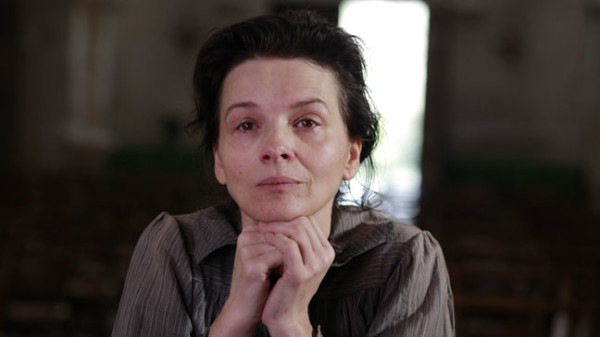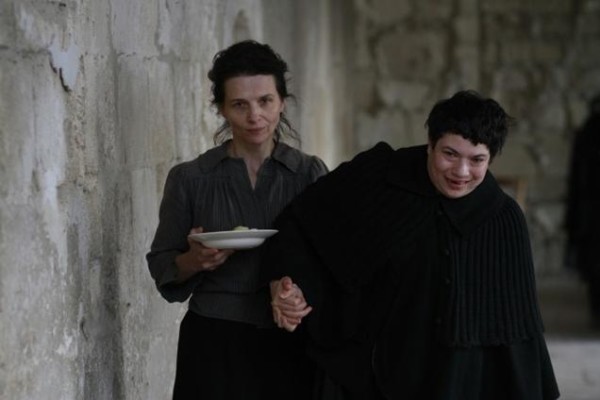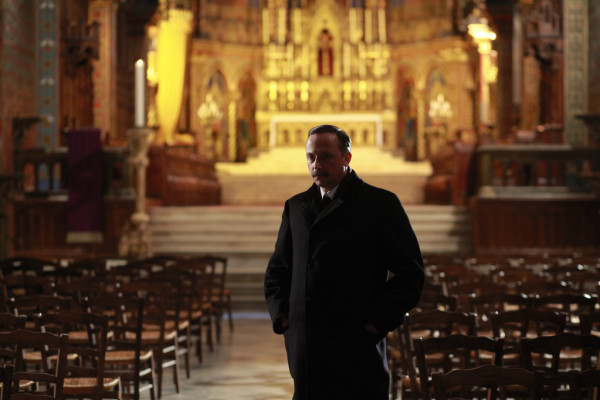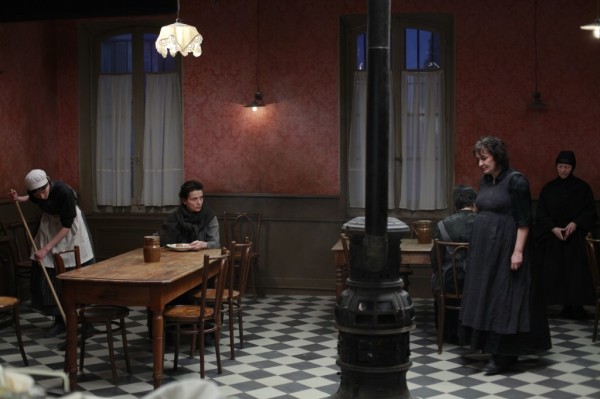
Camille Claudel 1915 (2013) isn’t remotely interested in the routine trajectory of biopics which take as their subject ‘the troubled artist’. It is a chamber piece drama about a brother and sister both inflicted with forms of insanity.
The latest picture to be released in the UK by Bruno Dumont stars Juliette Binoche in the role of Camille Claudel, whose tragic life in an asylum is as famous as her (surviving) sculptures. She has entered the popular imagination as a romantic figure whose genius was thwarted by mental illness, events conspiring against her and a domineering younger brother. A romantic portrait, however, is the last thing you’ll ever get from a director such as Dumont. Camille Claudel 1915 is the story of the artist as an abandoned person and the antithesis of the traditional melodramatic biopic.
The one scene in which the artist picks up a fistful of mud and begins to shape it with her hand is an inversion of those clichéd montage sequences in which the painter begins to paint an acclaimed masterpiece or the writer sits down at the desk bashing out the first lines of their greatest novel. After a momentary return to old pleasures, she becomes disgusted and throws the mud back onto the ground. Claudel destroyed many art pieces in fits of rage.
The director’s clever and unusual tactics are apparent from the start. The film opens with a shot of Camille’s head – the back of it. (Imagine a Hammershøi painting that swapped a middle class apartment for the asylum.) Her hair is tangled and unkempt and the clothes look like workhouse rags. The patient stands in a chilly stone-floor corridor, waiting for her turn to take a dip in the communal bath. There is nothing special about this woman, here in the hospital. She is just another patient standing in line, waiting for her turn to be bathed by the nurses.
In the next shot, Camille is stripped and placed in the tub and washed. The nurses comment on how dirty she is. Flesh can get mucky, but it can be cleansed. What about the soul? (Camille’s soul is of paramount concern for her brother, Paul.) The camera is focused on Camille’s intense displeasure. The scowl is hate-filled, but also profoundly sad. Actress Juliette Binoche was equally stripped of typical comforts: the script, makeup and the time to rehearse scenes. There would be no special treatment, either. In under a minute, within two shots, the entire tone is set for the rest of the film. Camille’s sorry world is presented as isolated, claustrophobic, humiliating and with no allowance for personal space or freedom.

Dumont used patients from a mental health hospital as extras and minor characters. Taking inspiration from Camille’s letters, we hear the former artist, several times in fact, refer to her fellow patients as ‘creatures’. The director’s inspired tactic – Dumont acquired their participation through an arts-therapy programme – puts the audience on the spot and is a clever route to empathising with Camille, who is nowhere near as ill as those around her and also a way to observe her snobbery. It’s all understandable, really. She didn’t belong at the austere environment of Montdeverges hospital, despite outbursts of paranoia and her conspiracy theories. The treatment by the family, who effectively disowned her, was brutal.
Like Tod Browning’s controversial 1932 picture, Freaks, Camille Claudel 1915 forces us to look at those we like to hide away. But faces are so vitally important in Dumont’s work. He often goes for non-professional performers and finds milling around his neck of the woods (the Pas de Calais region of northern France). The camera and Dumont’s conceptual principles transforms them into award-winning film stars. It’s not a new method at all, but it seems to irk some critics when these non-professionals bag coveted awards and it would terrify Hollywood to its core. Dumont gives us timeless faces – faces that could be found in a medieval painting or feel almost beatific in their intensity. Without the camera’s gaze and the framing, these are faces you’d pass by on the street and feel nothing for. Binoche is put through the same regime and it is a remarkable transformation and arguably the greatest performance of her career. She completely disappears into the role. The faces, too, in Camille Claudel 1915 bring to mind Van Gogh’s The Potato Eaters. Funnily enough, potatoes are all that the residents of the hospital seem to eat.

The story takes place over three days, with Camille awaiting the visit of her brother. In thirty years locked away, he visited seven times. He is the celebrated writer and poet, Paul Claudel. This plot point, the arrival of Paul, is crucial for the third act switch. The narrative is pivotal, too, as it is set at a time when the patient held hope that she might be released from her ordeal at the asylum. Even the doctors argued that she really might best be served returning to her beloved Villeneuve and taken care of there. History tells us she never left the place, but during this time there was a feeling it might happen, even if Camille was uncertain and wavering. However, after five minutes in the company of Mr. Claudel, you’ll understand Camille’s fate is sealed.
For about an hour, we spend every scene with Camille. Nothing much happens. One of the main criticisms aimed at the film is the cut away from the asylum to Paul making his way there. If anything, Dumont throws us from one horrific situation to an even more intense one: it’s both a recontextualisation of the film’s premise and a brief examination of the spiritual beliefs of an equally crazy man.
Although the film’s title is focused on Camille, the brother’s decisions controlled her destiny and we have to have an inkling why he would refuse access to the family and a life outside. Paul’s thinking was plainly of its time: sexist, patriarchal, socially embarrassed, uneducated about psychiatry and that being sent away was for the best. Yet there is no argument that he loved his sister and respected her as an artist. Paul’s own madness was not showy or demonstrated by panics or smashing up pieces of art. It’s as if he could handle the intensity of his communication with God but that he saw poor Camille as tormented and weak. The path to God could not be reached.

Paul worked professionally as diplomat and is affirmed as one of greatest, if controversial, French poets of the 20th century. Dumont has called him a genius equal to his sister. Deeply influenced by Symbolist poet Arthur Rimbaud’s rejection of materialism and striving to find a deeper meaning and order to the chaotic world, which was then in the early years of a world war, like others poets and writers such as W.H. Auden, T.S. Eliot and Graham Greene, he found succour in Catholicism.
In one scene, Paul talks to a priest about Camille being possessed (possession was also a theme in Dumont’s Hors Satan, 2009) and may have believed her time in the asylum would cleanse her soul. If she was never to leave, well, she would get into heaven, for sure. Paul, in essence, is very much like Dumont’s teenage weirdo, Hadewijch. He is searching for absolute answers and wants to feel the divine. Can we say, therefore, that Hadewijch (2009, Hors Satan (2011) and Camille Claudel 1915 form a loose trilogy? The films are invested with characters either desiring and exhibiting a connection to high powers. In the latter two films, possession (as in demonic or spiritual corruption) is a thematic thread.
To highlight this notion of religious intoxication and the disconnect that Paul and his sister, Dumont shows his praying to God as seriously, even comically, intense. When we see Camille kneeling on a pew in the hospital chapel, it looks somehow less sincere. She’s crouched muttering like, well, a sad and desperate person. Paul has convinced himself of a direct connection to God. It is clear that he’s got the spirit and can handle such divine blessings, whereas, his sister cannot. This is the heart of the tragedy and the false premise Paul invested in so heavily.
Camille died in 1943, aged 78, and was buried in an unmarked grave. Nobody from the family attended the funeral. The Claudels left to history their art and a fascinating sibling relationship from which Bruno Dumont was able to craft his latest cinematic marvel.
Camille Claudel 1915 is out now in select UK cinemas












{ 0 comments… add one now }